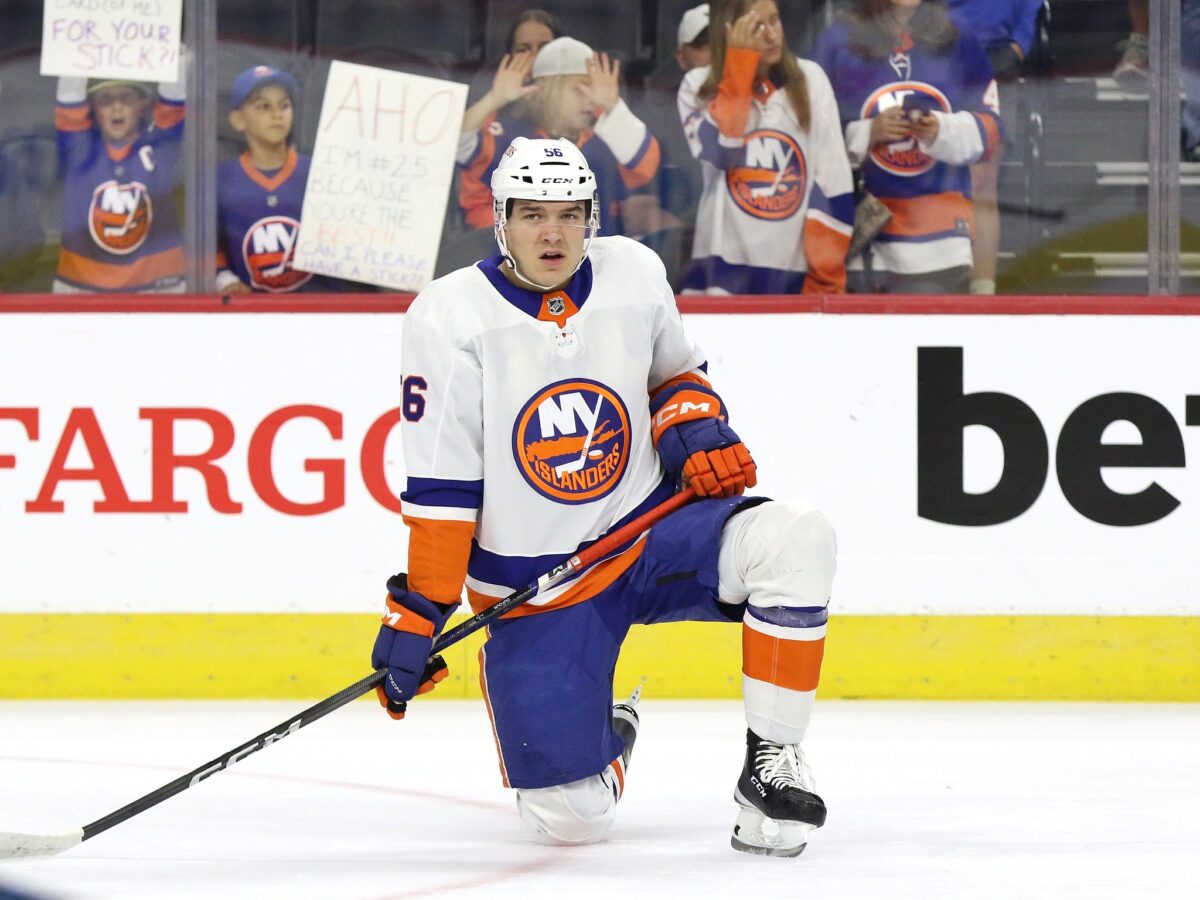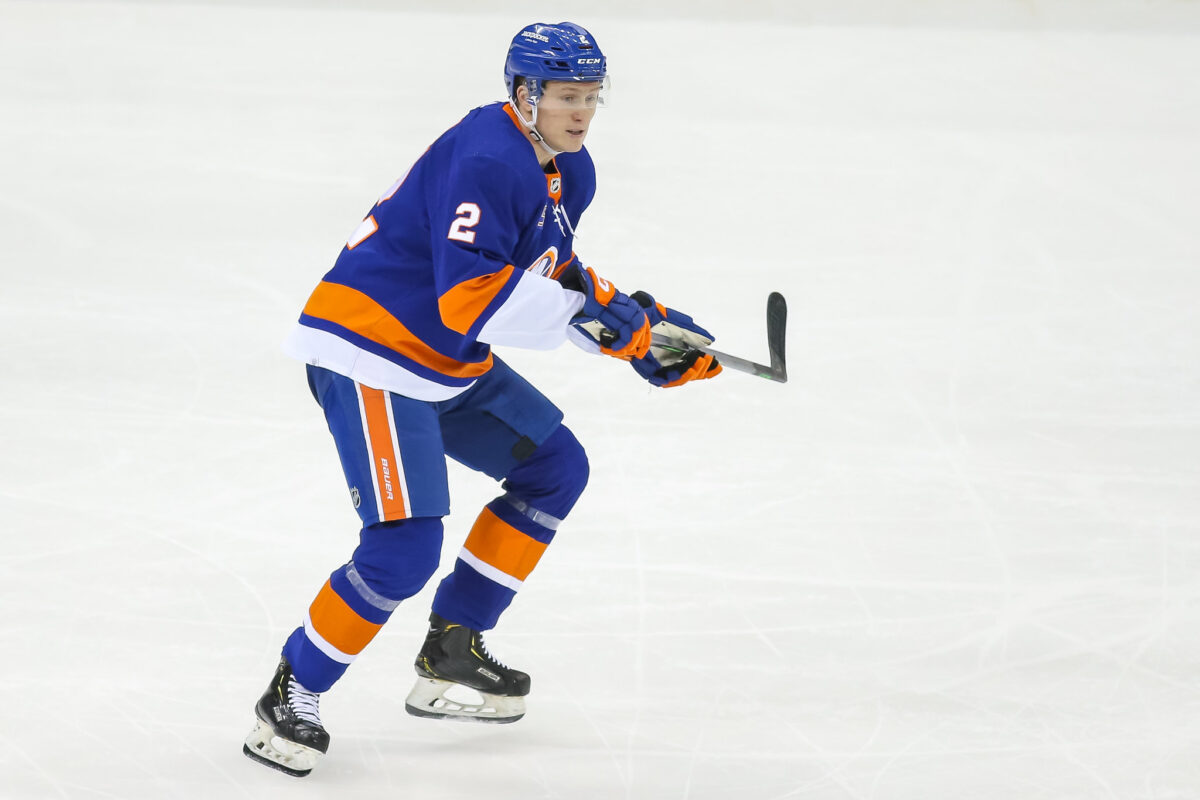The Bridgeport Islanders have the worst offense in the American Hockey League. They average only 2.21 goals per game and have been held to one goal or fewer in five of their last 11 games. It’s not the primary reason the Islanders sit in last place in the Atlantic Division and with a 24-36-6-2 record are already eliminated from the playoffs, but it’s a big one.
Related: Ty Smith Can Be a Wild-Card for the Hurricanes Defense
They scored three goals in the 6-3 loss to the Wilkes-Barre Scranton Penguins on April 6. To prove it wasn’t a fluke, they scored four unanswered goals in the next game on April 7 against the Rochester Americans to force a shootout (they lost 5-4 in the end). Two games is a small sample size considering the Islanders have played 68 of 76 games already, but it’s a promising sign for the short and long-term outlooks.
The offensive woes have hurt this team all season and have kept them in last place in the standings. There are plenty of issues throughout the lineup yet some help is on the way and the future looks positive, especially if change happens from both a roster standpoint and how the team plays on the ice.
Islanders Need Scoring Depth
Ruslan Iskhakov, Matthew Maggio, and William Dufour have scored 48 of the Islanders’ 152 goals this season. It doesn’t take a mathematician to realize that three skaters have accounted for a significant amount of the offense (roughly one-third of it from a goal-scoring standpoint). The 6-3 loss to the Penguins was a good case in point to how top-heavy the offense is as Dufour and Maggio scored and each added an assist while the rest of the offense didn’t show up.

Outside of that trio, the forward unit is filled with forecheckers who struggle to find the back of the net. Only five skaters have 10 goals or more, while eight skaters have 10 assists or more. Opponents can eliminate the bottom six when there isn’t a scoring presence and they’ve done just that. Having a hard-hitting presence is valuable in a forward unit and toughness often gives a team an edge, as the playoffs tend to prove time and time again. The problem is when it consumes the unit, it leaves the offense a mess.
The good news is that help is on the way, specifically with Alex Jefferies, Matt Kopperud, and Jack Randl have all been signed in recent weeks and will be a part of the roster for the final few games of this season and for next season. Jefferies has been the fastest to adapt as he’s found his footing and in seven games has already scored three goals and added an assist. His transition from the National Collegiate Athletic Association (NCAA) to the AHL was difficult at first but he’s built for it. “The pressure defensemen put on you” was the biggest difference he mentioned following the April 7 game. “Teams are more structured too. It’s tougher to come into the neutral zone,” he added.
His goal against the Americans came on a breakaway where he shrugged off the two defensemen and fired a shot to the top shelf to give the Islanders their first goal of the game. He’s not a power forward at 6-feet and 190 pounds but he can use his size to create space to generate shots on the net.
Along with the trio that was recently signed, Danny Nelson and Quinn Finley — who is one of the most underrated prospects in the system — are both poised to make an impact in the future. It might not be next season but by the start of the 2025-26 season, they’ll both add a scoring presence. It also helps that Calle Odelius and Isaiah George, the top two defense prospects in the Islanders system, are two-way players and both could help set up the offense down the road.
Quality vs. Quantity
The Islanders have no trouble getting shots on the net. They average 30.55 shots per game which is a top-10 mark in the AHL. Against the Americans, they generated 37 shots making a four-goal output feel disappointing. The problem is that they aren’t getting them from effective areas.

Dennis Cholowski’s game-tying goal against the Americans came from a tough angle as he flipped the puck on the net from along the boards and it zipped into the goal. The other three goals the Islanders scored came on the rush where the skaters had space to operate and easy looks on the net. When it comes to generating scoring chances in the offensive zone, the Islanders struggle.
They must generate shots from the face-off circles, the slot, and the high-danger areas instead of from along the boards and the point. This leads to the net issue where the Islanders lack puck-handlers on their forward unit. Iskhakov is one of them but Dufour and Maggio, the other two scorers, are still developing in that regard. It’s not just a lack of scoring depth: there’s a void when it comes to skaters who can set up the offense and control the puck. The result is a stagnant offense that tends to fire the puck on the net with minimal action otherwise.
Islanders Hope For Power Play Improvement
Even in the offensive outburst, the power play continues to look hapless going zero-for-eight in the two games and they’ve failed to score on the man advantage in their last 17 opportunities. The last time the Islanders found the back of the net on the man advantage was the March 29 game against the Charlotte Checkers, a game they lost 4-1. The power play is scoring only 13.3% of the time, which is the worst in the AHL and indicative of a terrible unit.
The power play has no puck movement and skaters aren’t connecting on cross-ice or centering passes. On top of that, they often fail to establish an offensive zone presence as they lack skaters who can move the puck up the ice. It’s an issue that has plagued the NHL teams with only a handful of skaters possessing the puck-handling ability to start up the offense and it looks like something that will hurt this team in the future as well (unless they add a skater in the draft or via trade who can help with that).
Dufour is the skater who can turn the power play into a strength as he has a great shot and can find open skaters near the net with his passing. He’s scored six of his 15 goals on the man advantage this season, which leads the team. He can only help to a point. Dufour needs skaters who can get the puck to him in space and other players on the power play who can open up the ice for him to make an impact on the wing. One skater can’t singlehandedly carry a unit and the Islanders have witnessed that firsthand.
Where is the Offense Coming From?
The crux of the offensive struggles comes from how the offense is generated. The argument can be made that it’s a chain reaction since the Islanders don’t have strong puck handlers and can’t create near the net but the bottom line is that they are trying to find the back of the net with good bounces and some luck. Simply, the Islanders fire the puck on the net from the point and hope for the best.
It’s a common sight as this team will have the defensemen fling the puck to the goal where it is often blocked by the opposition or covered up by the opposing goaltender. Sure, they’ll find the back of the net once in a while, after all, Cholowski has seven goals and Robin Salo has five. However, this strategy is not sustainable as the season has shown.

For as much as the fans criticize Anders Lee, who has regressed as a skater and he become a one-dimensional player for the New York Islanders offense, the AHL team could use a skater like him if they want to generate offense in this manner in the future. They need a bigger-bodied forward who can get to the net and the dirty areas to finish scoring chances and take advantage of loose pucks near the net. Their best scorers can’t do that. Iskhakov is one of the smaller skaters on the team and often gets pushed around when he tries to get to those areas while Dufour and Maggio are both shoot-first players who might look to develop a finishing ability.
To fix this issue, the Islanders can try to add more skaters who can get to those areas but more importantly, it’s about a change in mindset. Generating offense from the point isn’t sustainable and it will keep them a step behind the rest of the league. Instead, the team needs to develop forwards who can create in the offensive zone and with effective puck movement. They might struggle at first but after a few games, the team will have something brewing.
Where The Islanders’ Offense Will Improve In the Futture
There’s a lot of uncertainty heading into the offseason, similar to any other team in the AHL. Some skaters will be called up to the NHL, while others will move on and look to play in other leagues both in North America and overseas. Kyle MacLean scored six goals and 16 assists before joining the NHL roster halfway through the season and he’s poised to remain on the team as a fourth-line skater. The other top skaters are hoping to follow in his path by joining the pro team and more departures will further weaken the offense.
That said, the recent two games were a reminder that this team has the pieces to turn the offense around. “I think we have good players but things weren’t going our way,” Jefferies noted after the game against the Americans and it’s a sentiment that Jeff Kubiak and Carsen Twarynski stated earlier in the season as well. The team has the talent but whether it’s simple bad luck or bad luck by design, the offense isn’t maximizing its potential. The hope is that it will be next season.
Jefferies will play a big role in that offensive turnaround. The scoring touch is there and for him to take the next step as a prospect, he must work on the other aspects of his game as well. “(I’m) Just trying to do all the little things,” he said, and that includes both his ability to find open skaters and become a reliable forward in the defensive end of the ice as well.
The Islanders will also keep an eye out for the defense prospects who can join the team. Odelius and George are both two-way defensemen who can handle the puck and help set up the offense and it’s a void on the AHL roster that they can address. There’s no telling if either skater will be on the team to start next season but they, like Jefferies, provide hope.
The offense also will improve with more discipline and better play from the skaters who return. One of the biggest changes Iskhakov noted was that they were “just staying on pucks” to allow them to maintain possession throughout the recent games. Another issue is playing from behind, something the Islanders have done throughout the season. “It’s tough to come back, if we start better it will be better for us,” Jefferies mentioned as an area for improvement. Even with the offense being riddled with issues, there’s still hope that things will improve down the road as the team tries to look past a forgettable 2023-24 season and look ahead to 2024-25.